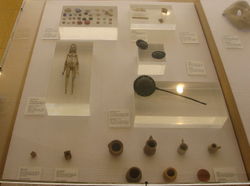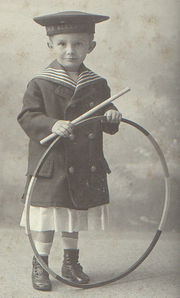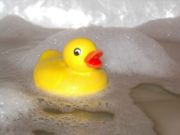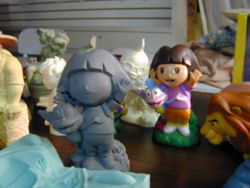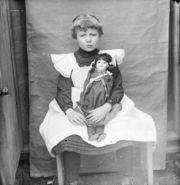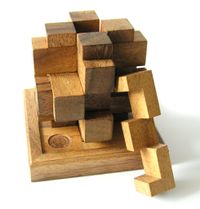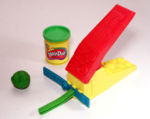Toy
2007 Schools Wikipedia Selection. Related subjects: Everyday life
A toy is an object meant to be played with. Toys are usually associated with children and pets, but it is not unusual for adult humans and some non- domesticated animals to play with toys. Many items are manufactured to serve as toys, but items produced for other purposes can also be used as toys. A child may pick up a household item and 'fly' it around pretending that it is an airplane, or an animal might play with a pinecone by batting at it, chasing it, and throwing it up in the air. Some toys are intended primarily as Collector's items and are not to be played with.
The origin of toys is prehistoric; dolls of infants, animals, or soldiers, and miniature representations of the tools of adults are readily found at archaeological sites. The origin of the word is unknown, but it is believed to have been first used in the 14th century.
Toys and play in general are an important part of the process of learning about the world and growing up. The young use toys and play to discover their identity, help their bodies grow strong, learn cause and effect, explore relationships, and practice skills they will need as adults. Adults use toys and play to form and strengthen social bonds, teach the young, remember and reinforce lessons from their own youth, exercise their minds and bodies, practice skills they may not use every day, and decorate their living spaces. Toys are more than simple amusement, and they and the way they are used profoundly influence most aspects of life.
History
Most young mammals play, and will play with whatever they can find, turning such things as pinecones or rocks into toys. It simply makes sense then that toys have a history as old as human civilization itself. Toys and games have been unearthed from the sites of ancient civilizations. They have been written about in some of our oldest literature. Toys excavated from the Indus valley civilization (3000-1500 BCE) include small carts, whistles shaped like birds, and toy monkeys which could slide down a string.
The earliest toys were made from materials found in nature, such as rocks, sticks, and clay. Dolls are some of the oldest types of toy. Thousands of years ago, Egyptian children played with dolls with wigs and movable limbs which were made from stone, pottery, and wood. In Ancient Greece and Ancient Rome, children played with dolls made of wax or terra cotta, sticks, bows and arrows, and yo-yos. When Greek children came of age it was customary for them to sacrifice the toys of their childhood to the gods.
As technology changed and civilization progressed to what it is today, toys also changed. Whereas ancient toys were made from materials found in nature like stone, wood, and grass modern toys are often made from plastic, cloth, and synthentic materials. Ancient toys were often made by the parents and family of the children who used them, or by the children themselves, nowadays modern toys are often mass-produced and sold in stores.
One example of this change in the nature of toys is embodied by the changes that have taken place in one of the oldest and most universal of human toys; dolls. The earliest dolls were simple wooden carvings and bundles of grass; Egyptian dolls were sometimes jointed so that their limbs could move realistically; dolls that could say "mama" were around in the early 1800s; and today there are dolls that can recognize and identify objects, the voice of their owner, and choose among hundreds of pre-programed phrases with which to respond. The materials that toys are made from have changed, what toys can do has changed, but the fact that children play with toys has not changed.
Toys in child development
Toys, like play itself, serve multiple purposes in both humans and animals. They provide entertainment while fulfilling an educational roll. Toys enhance cognitive behaviour and stimulate creativity. They aid in the development of physical and mental skills which are necessary in later life.
Toys for infants often make use of distinctive sounds, bright colors, and unique textures. Through play with toys infants begin to recognize shapes and colors. Repetition reinforces memory. Children begin to recognize cause and effect. Coordination and other manual skills develop from childhood interaction with toys. Marbles, jackstones, and stackable blocks require use of hands and bodies. Mental agility is challenged by the spatial relationships seen in toys. Play-Doh, Silly Putty and other hands-on materials allow the child to make toys of their own.
Educational toys for school age children of often contain a puzzle, problem-solving technique, or mathematical proposition. Often toys designed for older audiences, such as teenagers or adults demonstrate advanced concepts. Newton's cradle, a desk toy designed by Simon Prebble, demonstrates the conservation of momentum and energy.
Not all toys are appropriate for all ages of children. Some toys which are marketed for a specific age range can even harm the development of children in that range.
Toys and gender
Certain toys, such as dolls or trucks, are often perceived to be more acceptable for one gender then the other. It has been noted by researchers that, "Children as young as 18 months display sex-stereotyped toy choices". In addition to being provided with and choosing different toys, little boys and little girls typically play with gender neutral toys in different ways. Given a toy telephone with wheels, little girls will often pick it up and start talking, whereas little boys will often push it around like a toy vehicle. Most people, experts and laypeople alike, believe that gender-typical toy choices are due to environmental conditioning, however, recently there has been research on the subject of a biological difference in the way male and female children perceive toys.
Playing with toys stereotyped for the opposite gender sometimes results in negative consequences from parents or fellow children. In recent years in the west girls playing toys perceived as being for boys has gained acceptance; but boys playing with dolls is still seen as somewhat disconcerting.
Feminists have criticised these traditional sex roles, including as expressed in toys, as furthering the subservience of women -- boys' toys encourage them to be active and take dominant roles, whereas girls' toys they see as expressing the view that the proper concerns of women should be child rearing and their own bodies (fashion) rather than economic activity. Feminists, and some psychologists and social scientists, see these gendered patterns of toys as not originating in any innate part of male or female biology, but rather in what toys parents are accultured to see as appropriate for each gender child, and which thus from that the children themselves come to see as appropriate also. An opposing school of psychologists and social scientists has however claimed that the male and female differences in toys are rooted not in cultural but in the differing biologies and genetics of the male and female brains. The former school is predominantly associated with the political and religious left, whereas the latter school is predominantly associated with the political and religious right.
Economics
With toys comprising such a large and important part of human existence, it makes sense that the toy industry would have a substantial economic impact. In 2005, for example traditional toy sales in the United States totaled about $21.3 billion. Money spent on children between the ages of 8 and twelve alone totals approximately $221 billion annually in the U.S. Toy makers change and adapt their toys to meet the changing demands of children thereby gaining a larger share of the substantial market.
Promotional toys
Many successful films, television programs, books and sport teams have official merchandise, which often includes related toys. Some notable examples are Star Wars (a science fiction film series) and Manchester United, an English football club.
Promotional toys can fall into any of the other toy categories; for example they can be dolls or action figures based on the characters of movies or professional athletes, or they can be balls, yo-yos, and lunch boxes with logos on them. Sometimes they are given away for free as a form of advertising. Many food manufacturers will run promotions where a toy will be included with the main product as a sort of bonus. Some people go to great lengths to collect these sorts of promotional toys.
Types of toys
Construction toys
The Greek philosopher Plato wrote that the future architect should play at building houses as a child. A construction set is a collection of separate pieces that can be joined together to create models. Popular models to make include cars, spaceships, and houses. The things that are built are sometimes used as toys once completed, but generally speaking, the object is to build things of one's own design, and old models often are broken up and the pieces reused in new models.
The oldest and, perhaps most common construction toy is a set of simple wooden blocks, which are often painted in bright colors and given to babies and toddlers. Construction sets such as LEGO bricks and Lincoln Logs are designed for slightly older children and have been quite popular in the last century. Construction sets appeal to children (and adults) who like to work with their hands, puzzle solvers, and imaginative sorts.
Some other examples include Bayko, Erector Sets, and Tinkertoys.
Dolls, animals, and miniatures
A doll is a model of a human (often a baby), a humanoid (like Bert and Ernie), or an animal. Modern dolls are often made of cloth or plastic. Other materials that are, or have been, used in the manufacture of dolls include cornhusks, bone, stone, wood, porcelain (sometimes called china), bisque, celluloid, wax, and even apples. Often people will make dolls out of whatever materials are available to them.
Sometimes intended as decorations, keepsakes, or collectables for older children and adults, most dolls are intended as toys for children, usually girls, to play with. Some dolls have cultural significance, and they are occasionally used in ceremonies or rituals, or as physical representations of a deity. Dolls have been found in Egyptian tombs which date to as early as 2000 BC.
Dolls are usually miniatures, but baby dolls may be of true size and weight. A doll or stuffed animal of soft material is sometimes called a plush toy or plushie. A popular toy of this type is the Teddy Bear.
A distinction is often made between dolls and action figures, which are generally of plastic or semi-metallic construction and poseable to some extent, and often are merchandising from television shows or films which feature the characters. Modern action figures, such as Action Man, are often marketed towards boys, whereas dolls are often marketed towards girls.
Toy soldiers, perhaps a precursor to modern action figures, have been a popular toy for centuries. They allow children to act out battles, often with toy military equipment and a castle or fort. Miniature animal figures are also widespread, with children perhaps acting out farm activities with animals and equipment centered around a toy farm.
Toy vehicles
Children have played with miniature versions of vehicles since ancient times, with toy two-wheeled carts being depicted on ancient Greek vases. Modern equivalents include toy cars such as those produced by Matchbox or Hot Wheels, miniature aircraft, toy boats, and trains. Examples of the latter range from wooden sets for younger children such as BRIO complicated realistic train models like those produced by Lionel and Hornby.
Puzzles
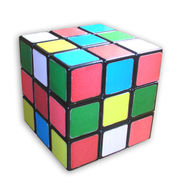
A puzzle is a problem or enigma that challenges ingenuity. Solutions to puzzle may require recognizing patterns and creating a particular order. People with a high inductive reasoning aptitude may be better at solving these puzzles than others. Puzzles based on the process of inquiry and discovery to complete may be solved faster by those with good deduction skills.
The history of puzzles goes back many thousands of years.
There are many different types of puzzles, for example a maze is a type of tour puzzle. Other categories include; construction puzzles, stick puzzles, tiling puzzles, transport puzzles, disentanglement puzzles, sliding puzzles, logic puzzles, picture puzzles, lock puzzles and mechanical puzzles.
History of mechanical puzzles
The oldest known mechanical puzzle comes from Greece and appeared in the 3rd century BC. The game consists of a square divided into 14 parts, and the aim was to create different shapes from these pieces. In Iran “puzzle-locks” were made as early as the 17th century AD. In 1742 Japan there is a mention of a game called “Sei Shona-gon Chie No-Ita” in a book. Around the year 1800 the Tangram puzzle from China became popular, and 20 years later it had spread through Europe and America. The company Richter from Rudolstadt began producing large amounts of Tangram-like puzzles of different shapes, the so-called “Anker-puzzles”.
Puzzles were greatly fashionable towards the end of the 19th century and the beginning of the 20th century. The first patents for puzzles were recorded at this time. In 1893 professor Hoffman wrote a book called “Puzzles Old and New”. It contained, amongst other things, more than 40 descriptions of puzzles with secret opening mechanisms. This book grew into a reference work for puzzle games and modern copies exist for those interested.
With the invention of materials easy to shape such as plastic, the range of puzzle possibilities grew. Rubik's Cube, arguably the most famous puzzle worldwide, would not be possible without modern polymers.
Toys that involve physical activity
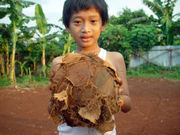
A great many toys are part of active play. These include traditional toys such as hoops, tops, jump ropes and balls, as well as more modern toys like Frisbees, foot bags (such as Hacky Sacks), astrojax, myachi, and the yo-yo.
Playing with these sorts of toys allows children to exercise, building strong bones and muscles and aiding in physical fitness. Throwing and catching balls and frisbees can improve hand-eye coordination. Jumping rope and playing with foot bags can improve balance.
Collectable toys
Some toys, such as Beanie Babies, attract large numbers of enthusiasts, eventually becoming collectables. Other toys, such as Boyds Bears are marketed to adults as collectables. Some people spend large sums of money in an effort to acquire larger and more complete collections. The record for a single Pez dispenser at auction, for example, is $1,100 U.S.
Invention of toys
After trying to create a replacement for synthetic rubber, Earl Warrick inadvertently invented "nutty putty" during World War II. Later, Peter Hodgson recognized the potential as a childhood plaything and packaged it as Silly Putty. Similarly, Play-Doh was created as a wallpaper cleaner. In 1943 Richard James was experimenting with torsion springs as part of his military research when he saw one come loose and fall to the floor. He was intrigued by the way it flopped around on the floor. He spent two years fine-tuning the design to find the best gauge of steel and coil. After a name change, the Slinky was sold as a toy for both genders in stores throughout the United States.
Regulations
Many countries have passed laws regarding the types of toys that can be sold. Most of these seek to limit potential hazards, such as choking hazards, fire hazards, and other conditions that could cause injury. Children, especially very small ones, often put toys into their mouths, so the types of materials that go into making a toy are often regulated to prevent poisioning. Materials can also be regulated to prevent fire hazards. Children have not yet learned to judge what is safe and what is dangerous, and parents do not always think of all possible situations, so such warnings serve a practical purpose on toys.
European regulations
The most comprehensive legislation is the Toy Safety Directive of the European Union (EU) ( Council Directive 83/189/EEC). This directive is a list of requirements toys must comply with, and is interpreted in the laws of each member state of the EU in their respective Toy Safety Regulations (e.g.: the UK's Toys (Safety) Regulations 1995 (Statutory Instrument 1995 No. 204)). Compliance leads to a CE Mark, which is a mandatory requirement for selling the toy in the EU market. Some items included in the scope of this legislation which are not usually considered toys are; fashion jewelery for children, Christmas decorations, and air guns. The directive provides EU-wide standards on physical and mechanical properties, flammability, chemical properties, electrical properties, hygiene, and radioactivity. The Toys Safety Directive (and subsequent state regulations) also calls for the closest applicable national or international standards to be applied where a standard is not specified in the Directive. This interpretive clause is present to ensure that new and innovative toys are safe before being placed on the market. If a toy is found to be unsafe (by breaching one of the specified standards, or by a manifest risk of injury not specified in standards) then the producer (the manufacturer, or the first importer into the EU of the product unit in question) is held to be guilty of an offence under the Toys (Safety) Regulations (or equivalent EU state law). The principle of due diligence (whereby the producer argues that all reasonable steps were taken to ensure the safety of the consumer with regards to the toy) may be used by the producer to avoid prosecution, fines and possible imprisonment. The unsafe toy is withdrawn from the EU market, with all member states' authorities being notified by means of the RAPEX alert system.
Disposal of toys
When toys have been outgrown or are no longer wanted, reuse should always be considered. They can be donated via many charities, sold at garage sales, auctioned, sometimes even donated to museums. However, when toys are broken, worn out or otherwise unfit for use, care should be taken when disposing of them. Before disposal of any battery-operated toy, batteries should be removed and properly recycled or disposed of as outlined in your community. Most toys will not be recyclable via normal methods. Placing toys in recycling bins can contaminate recyclables due to the unknown materials used. Most communities will ask that small toys be bagged and disposed as municipal solid waste with normal collection. Large toys such as outdoor playhouses and ride on toys can be treated as bulk waste. Some manufacturers, such as Little Tikes, will take back and recycle their products.


